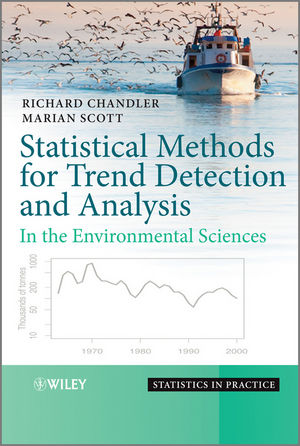Statistical Methods for Trend Detection and Analysis in the Environmental SciencesISBN: 978-0-470-01543-8
Hardcover
392 pages
April 2011
 |
||||||
Contributing authors.
Part I METHODOLOGY.
1 Introduction.
1.1 What is a trend?
1.2 Why analyse trends?
1.3 Some simple examples.
1.4 Considerations and Difficulties.
1.5 Scope of the book.
1.6 Further reading.
References.
2 Exploratory analysis.
2.1 Data visualisation.
2.2 Simple smoothing.
2.3 Linear filters.
2.4 Classical test procedures.
2.5 Concluding comments.
References.
3 Parametric modelling - deterministic trends.
3.1 The Linear trend.
3.2 Multiple regression techniques.
3.3 Violations of assumptions.
3.4 Nonlinear trends.
3.5 Generalized linear models.
3.6 Inference with small samples.
References.
4 Nonparametric trend estimation.
4.1 An introduction to nonparametric regression.
4.2 Multiple covariates.
4.3 Other nonparametric estimation techniques.
4.4 Parametric or nonparametric?
References.
5 Stochastic trends.
5.1 Stationary time series models and their properties.
5.2 Trend removal via differencing.
5.3 Long memory models.
5.4 Models for irregularly spaced series.
5.5 State space and structural models.
5.6 Nonlinear models.
References.
6 Other issues.
6.1 Multisite data.
6.2 Multivariate series.
6.3 Point process data.
6.4 Trends in extremes.
6.5 Censored data.
References.
Part II CASE STUDIES.
7 Additive models for sulphur dioxide pollution in Europe (Marco Giannitrapani, Adrian Bowman, E. Marian Scott and Ron Smith)
7.1 Introduction.
7.2 Additive models with correlated errors.
7.3 Models for the SO2 data.
7.4 Conclusions.
References.
8 Rainfall trends in southwest Western Australia (Richard E. Chandler, Bryson C. Bates and Stephen P. Charles).
8.1 Motivation.
8.2 The study region.
8.3 Data used in the study.
8.4 Modelling methodology.
8.5 Results.
8.6 Summary and conclusions.
References.
9 Estimation of Common tends for tropical index series (Alain F. Zuur, Elena N. Ieno, Christina Mazziotti, Giuseppe Montanari, Attilio Rinaldi and Carla Rita Ferrari).
9.1 Introduction.
9.2 Data exploration.
9.3 Common trends and additive modelling.
9.4 Dynamic factor analysis to estimate common trends.
9.5 Discussion.
Acknowledgement.
References.
10 A Space-time study on forest health (Thomas Kneib and Ludwig Fahrmeir).
10.1 Forest health: survey and data.
10.2 Regression models for longitudinal data with ordinal responses.
10.3 Spatiotemporal models.
10.4 Spatiotemporal modelling and analysis of forest health data.
Acknowledgements.
References.
Index.



